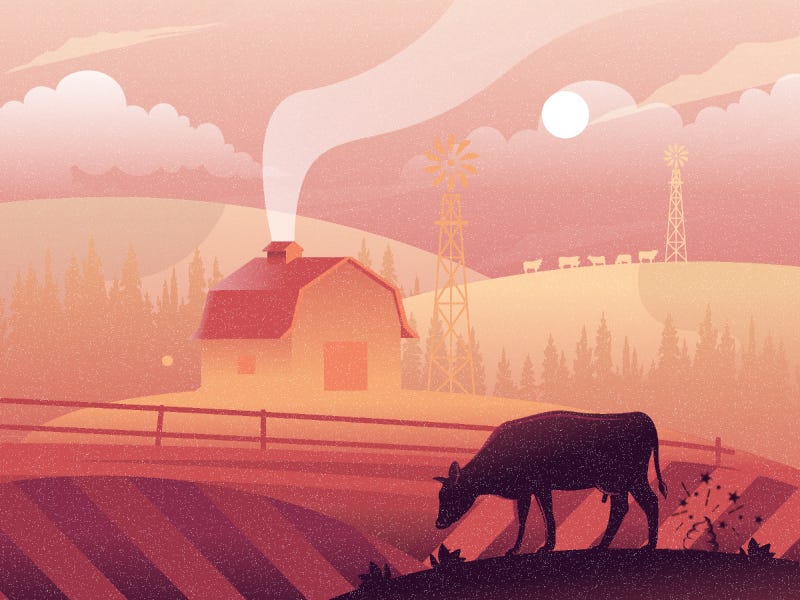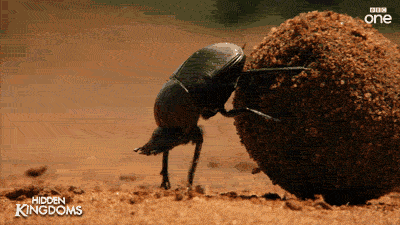💩The Magic of Cow Manure

Is manure a waste product or source of revitalization? The answer depends mainly on the production system in place: as the adage goes in the regenerative grazing community, “it’s not the cow, it’s the how.” With livestock animals producing 1.2–1.37 billion tons of excretion every year in the U.S. according to the CDC, every dropping of manure can spark a virtuous cycle in our soils in a regenerative operation or lead to water and air contamination in a centralized animal feeding operation (CAFO).
In a regenerative grazing system with frequent pasture rotations, primary usage of biological controls of pests, and a focus on soil health, cow manure catalyzes a buoyant ecosystem in each pasture. As Josh Tickell notes in Kiss the Ground, this process is a carbon sink as the manure-fertilized and cow-trampled grasses absorb carbon dioxide, with methanotrophic bacteria in a healthy soil system taking apart methane in manure. The manure is fairly equally distributed across individual paddocks and even cattle urine helps regulate soil pH (acidity).
A fundamental part of this cycle is the dung beetle, one of the most important visual cues for a regenerative operation. As entomologist Jonathan Lundgren puts it: ”You have nutrients down in your soil and then the plants take it up. Then the cows come by and eat those plants and poop out all that nutrition. So the only way the nutrients get back down into the soil so that the next generation of plants can be fertilized is with these dung insects.” Dung beetles provide numerous economical ecosystem services to every ranch, including:
Preventing Flies and Gastroenteric Parasites: Dung beetles have the potential to reduce fly populations in grazing settings by over 95%. The horn fly alone loses American livestock producers over $1 billion annually. Dung beetles compete with these fly populations for food (the manure) and win out.
Recycling and Removing Manure: The dung beetle’s natural process is perhaps the most efficient possible at this end. In a matter of hours, dung beetles roll up balls of the highest nitrogen dung and many burrow them in the soil’s rhizosphere. This sequesters nitrogen in the soil and, after beetle larvae consume upwards of 50% of the dung, the rest serves as a natural soil amendment for plant roots.
Water Infiltration: Dung beetles’ burrows improve the soil’s water cycle by creating room for better water infiltration. This also “leads” water directly to the rhizosphere, where roots can directly absorb water. In addition, the academic literature suggests they also reduce water runoff - meaning that nutrients will not flow away from the soil and lead to contamination.
In a CAFO, manure presents a difficult logistical challenge instead of a natural opportunity. Even if there are some pasture rotations, the use of common pesticides and dewormers kill parasites and continue in the manure to eliminate dung beetles (along with other beneficial insects and bacteria). As animal feces piles up in confined areas, the land cannot absorb it, thus leading to contaminated water supply (an estimated 55% of sediment pollution and 30+% of nutrient pollution in America’s drinking water comes from livestock manure), animal welfare issues (particularly with roundworms and flies), and the release of various pollutants, including ammonia, nitrous oxide, and methane. Merely getting rid of the manure poses major logistical problems, though recent innovations point in the right direction. These include using CAFO and dairy cattle manure:
As Compost: Cow manure is compost for crops and rangelands, but it needs to be effectively treated for safe handling and effective plant uptake. While manure compost is a worthwhile operation, the costs of transportation, equipment, and safe handling, and risks of misapplication by grower make it inferior to natural decomposition. This is unnecessarily complicated compared to how pasture-based systems incorporate manure.
In Anaerobic Digesters: Digesters cover a large swath of manure and use microbes, heat, and water to produce methane biogas for energy production, liquid manure for fertilizer, and solid manure for livestock bedding. The federal government and California both have subsidized digesters to the tune of hundreds of millions, with over 250 digesters built in the country. However, they cost millions to build - pricing out smaller operators - and do not address toxic runoff into water supplies.
The scalable solution to a better food production cycle is the appreciation for natural processes found in regenerative grazing. Though industrial producers have started investing in manure as a product instead of waste, those technologies are stop-gaps that only reduce carbon emissions when we need carbon sequestration and limit the scope of harm when we need regeneration.
Listen: On this episode of the Sustainable Dish Podcast, author Dianne Rogers speaks to Jason Rowntree and Paige Stanley from Michigan State University about adaptive multi-paddock grazing and how it all works on the ranch. Jason and Paige discuss their paper Impacts of soil carbon sequestration on life cycle greenhouse gas emissions in Midwestern USA beef finishing systems, one of the most influential analyses on how regenerative grazing compares to CAFO systems. They discuss the results of their paper, the impact of grazing livestock specifically Adaptive Multi-Paddock Grazing, and why eating meat may not be as bad for the environment as we think.
Devour: Our friends at Wholesome Meats recently released a fun and bold new video that helps educate viewers on regenerative agriculture. In this video, you'll meet Mother Nature who shines a light on feedlot beef and the fake meat industry. Watch it below! And if you liked it, make sure to use the code “MotherNature10” for a discount at checkout!
Disclaimer: The Regeneration Weekly receives no compensation or kickbacks for brand features - we are simply showcasing great new regenerative products.
If you have any products you would like to see featured, please respond to this newsletter or send an email to Kevin(at)soilworksnaturalcapital.com.
The Regeneration is brought to you by Wholesome Meats | Soilworks | Grassroots Carbon| Grazing Lands


